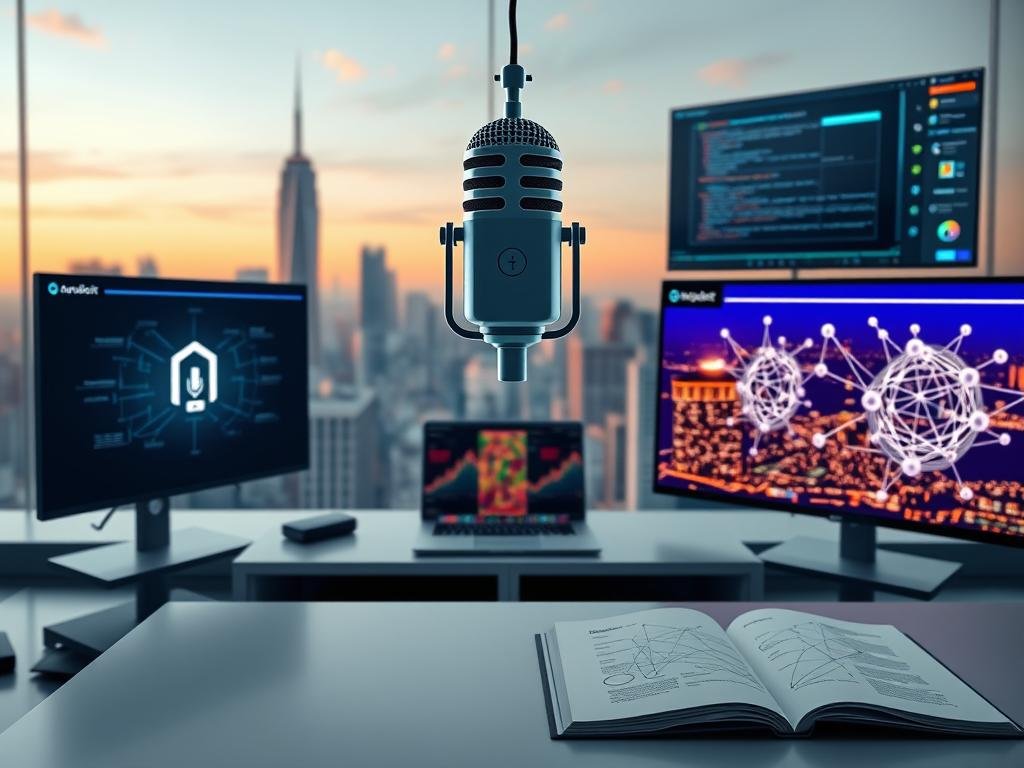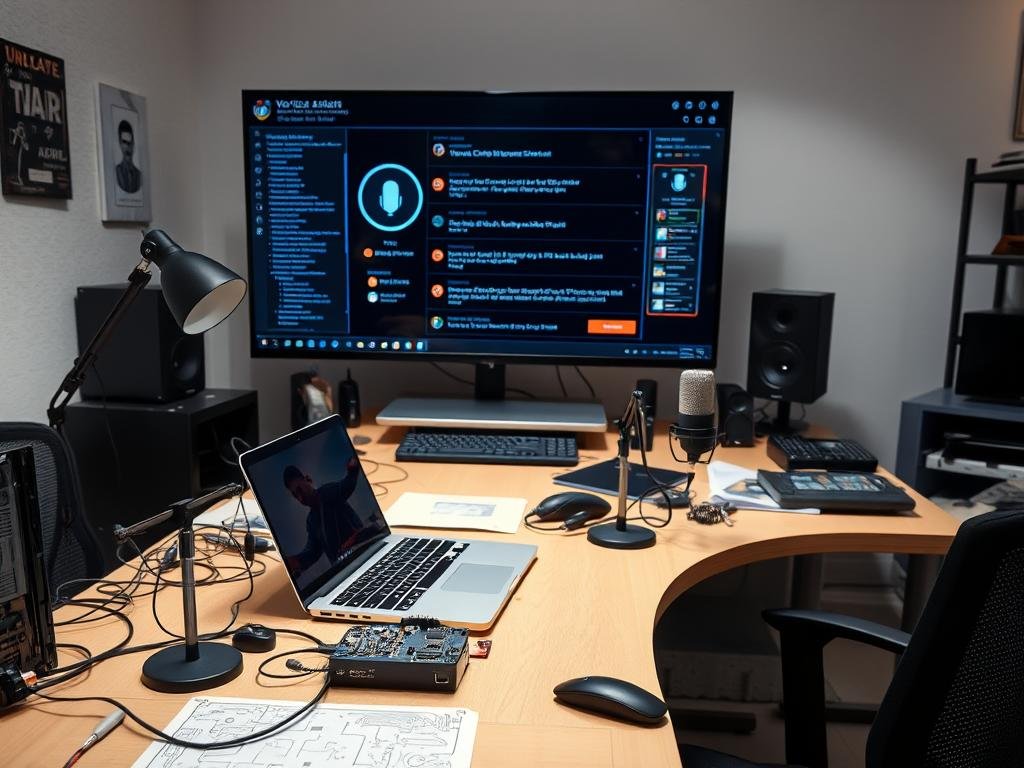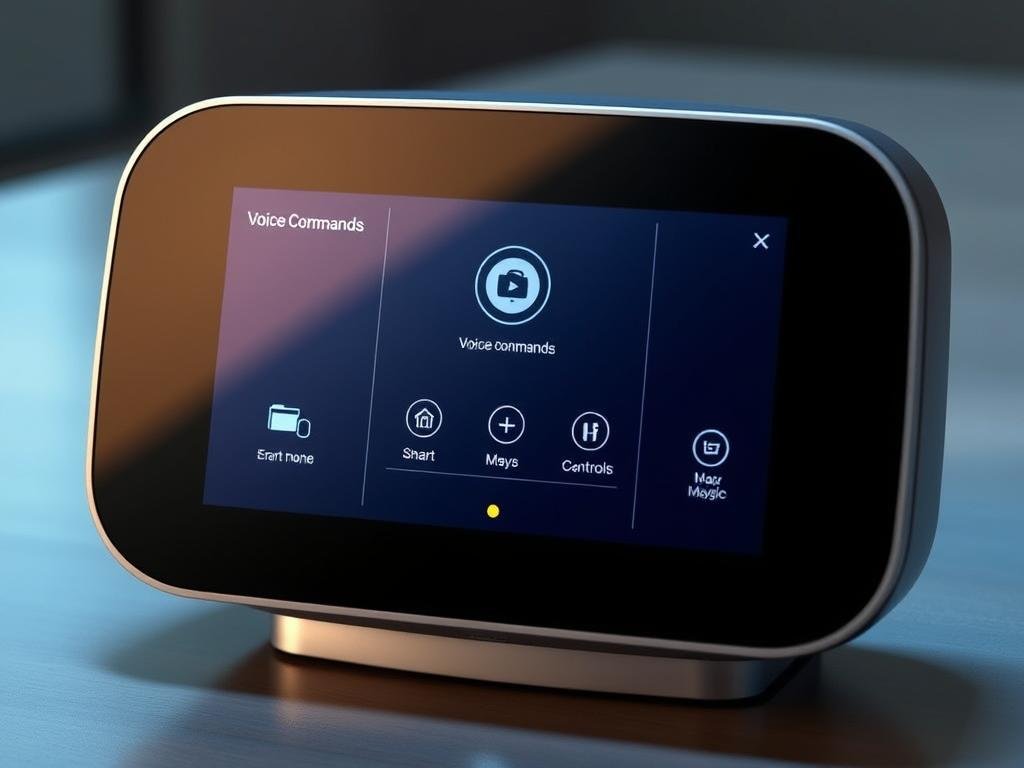Build a Smart Voice Assistant with AI. Imagine having a personal assistant that can understand your commands. It can control your smart home devices and give you information on demand. Thanks to AI technology, making such an assistant is now possible.
AI-powered voice assistants have changed how we use technology. They make it more intuitive and tailored to us.
You can create your own AI Voice Recognition system. This means defining what your assistant will do, picking the right tech, and training the AI. Doing this brings personalization, efficiency, and better privacy.
For more on AI assistants like Siri and Alexa, check out this resource.
Key Takeaways
- Understand the basics of AI Voice Recognition technology.
- Learn how to define the purpose and functionality of your voice assistant.
- Discover the steps involved in developing a custom voice assistant.
- Explore the benefits of having a personalized AI voice assistant.
- Gain insights into integrating your voice assistant with smart home devices.
What is a Smart Voice Assistant?
The rise of AI has brought us smart voice assistants. They can understand and respond to voice commands. These devices make managing daily tasks and controlling smart homes easy.
Understanding AI Technology
AI technology powers smart voice assistants. It uses Natural Language Processing (NLP) to understand human language. This lets voice assistants interpret voice commands and respond accurately.
For more on virtual assistants, check out The Future of Virtual Assistants Beyond.
Key Features of Voice Assistants
Smart voice assistants have many useful features. Some key ones are:
- Voice command functionality
- Smart home device control
- Information retrieval (news, weather, etc.)
- Entertainment (music, podcasts, etc.)
| Feature | Description | Benefit |
|---|---|---|
| Voice Command | Control devices with voice | Hands-free operation |
| Smart Home Control | Manage smart devices | Convenience and automation |
| Information Retrieval | Access news, weather, etc. | Stay informed on the go |
Knowing about AI and voice assistant features helps you see their value. You can even build your own smart voice assistant to meet your needs.
Benefits of Building Your Own Voice Assistant
Creating a smart voice assistant from scratch gives you unparalleled customization and control. You can make it fit your needs perfectly. This means adding features that matter most to you.
Customization to Your Needs
One big plus of making your own voice assistant is the chance to tailor it to your specific needs. Unlike ready-made options, you can make it work with your current smart devices. For example, you can create a voice assistant to control your smart home or even build a smart mirror with voice control.
Cost-Effectiveness
Building your own voice assistant can save you money in the long run. The upfront costs for hardware and software might seem high. But, it avoids subscription fees and other costs of commercial voice assistants. Plus, you can update it anytime, making it last longer and reducing waste.

Enhanced Privacy and Security
Another key benefit is enhanced privacy and security. With your own voice assistant, you control the data it handles. This keeps your conversations and personal info safe. It’s vital in today’s world where data breaches and cyber threats are common.
Essential Components for Your Voice Assistant
To make a good voice assistant, you need to know what hardware and software you’ll need. It takes a few important parts to make a voice assistant that can understand and talk back to you.
Hardware Requirements
The hardware is key for catching and playing back sounds. You’ll need:
- A microphone that can pick up voice commands well.
- A speaker to give clear sounds back to you.
- A strong processing unit, like a Raspberry Pi, to handle voice processing and AI tasks.
Software Requirements
The software is important for making sense of voice commands and answering them. You’ll need:
- NLP libraries like NLTK or spaCy to understand natural language.
- Machine learning frameworks like TensorFlow or PyTorch for AI model development.
- A programming language; Python is great for AI work because it’s easy to use and has lots of tools.
| Component | Description | Examples |
|---|---|---|
| Microphone | Captures voice commands | USB Microphones, ReSpeaker |
| Speaker | Provides audio feedback | Standard Speakers, Smart Speakers |
| NLP Libraries | Processes natural language | NLTK, spaCy |
| Machine Learning Frameworks | Develops and trains AI models | TensorFlow, PyTorch |
By putting together these hardware and software parts, you can make a voice assistant. It will understand and answer voice commands using AI Voice Recognition and Machine Learning Voice Interface tech.
Choosing the Right AI Framework
Choosing the right AI framework is key to making a smart voice assistant. The framework you pick will shape what your voice assistant can do and what it can’t.
Popular AI Frameworks
Many AI frameworks are popular for making Smart Speaker Software. TensorFlow, PyTorch, and spaCy are among them. Each has its own strengths and fits different needs in Voice Assistant Development.
TensorFlow is loved for its big community and is used for big projects. PyTorch is easy to use and flexible, great for quick tests and research. spaCy is known for fast text processing, which is key for voice assistants.

Comparing Framework Features
When looking at these frameworks, consider ease of use, performance, and how well they scale. Think about what’s most important for your project. For example, if you’re working on Natural Language Processing, choose a framework that’s strong in NLP.
Compare them based on:
- Support for deep learning models
- Integration with other tools and libraries
- Community support and documentation
- Performance on tasks like speech recognition
By looking at these points, you can choose the best framework for your Voice Assistant Development goals.
Setting Up Your Development Environment
Setting up your development environment is key to making a voice assistant with AI. You need to install tools and software. These will help you design, test, and deploy your voice assistant.
Tools You’ll Need
You’ll need a few important tools to begin. An Integrated Development Environment (IDE) for coding is a must. You’ll also need a version control system like Git and containerization tools like Docker.
An IDE like Visual Studio Code or IntelliJ IDEA offers great coding tools. These include syntax highlighting, code completion, and debugging tools.
Version control is vital for managing your codebase. It lets you work with others and track changes. Docker containers make sure your app works the same everywhere, making deployment easier.
Installation Steps
Here’s how to install these tools:
- Install an IDE: Download and install your preferred IDE. Most IDEs have easy installation processes.
- Set up Git: Download Git from its official website and follow the installation instructions for your operating system.
- Install Docker: Visit the Docker website to download Docker Desktop, and follow the installation prompts.
After installing these tools, you’re ready to start developing your voice assistant. Make sure your IDE is set up with the right plugins for your language. Also, ensure Git is set up for version control.

With your environment set up, you can now work on your voice assistant. This includes adding AI voice recognition and voice command technology. This foundation is essential for your project’s success.
Designing Your Voice Assistant’s Interface
Creating an easy-to-use interface for your voice assistant is key for a smooth user experience. As you work on your Virtual Assistant Integration, think about how users will interact with it. A well-designed interface can greatly enhance your users’ experience.
User Experience Considerations
When designing your voice assistant’s interface, consider the conversational flow. Anticipate the types of questions users will ask and design the interface to answer them well. For example, if you’re making a Natural Language Processing Assistant, plan how to handle complex questions.
Look at existing voice assistants and their interfaces for inspiration. You can also check out this guide on building an AI voice assistant to learn about effective interface design.
Visual Design Elements
The look of your voice assistant’s interface is as important as its function. Choose colors and fonts that look good and match your brand. For a Smart Speaker Software, the design should be simple and clear, helping users understand the information.

Go for a clean, simple design that highlights the most important features. Use design tools and software to make prototypes and test your designs.
For more on integrating your voice assistant with smart home systems, check out this resource on smart home technology.
Programming Your Voice Assistant
To make your voice assistant work, you need to program it. You’ll use a programming language and libraries. This step is key for your assistant to understand and answer voice commands well.
Choosing a Programming Language
Choosing the right programming language is important. Python is a top choice because it’s easy and has lots of libraries for AI and machine learning. TensorFlow and PyTorch are examples of these libraries.
Python is great for developers at any level. It has many libraries and frameworks. These make adding features like voice recognition and natural language processing easier.
Basic Code Structure
The code for your voice assistant needs NLP libraries and machine learning models. Use NLTK or SpaCy for natural language tasks. For machine learning, TensorFlow or PyTorch are good choices.
A basic code structure includes:
- Importing needed libraries
- Creating functions for voice command recognition
- Adding machine learning models for responses
Here’s a simple Python code example:
import speech_recognition as sr
import pyttsx3
# Start speech recognition and text-to-speech engines
r = sr.Recognizer()
engine = pyttsx3.init()
# Function to recognize voice commands
def recognize_command():
with sr.Microphone() as source:
audio = r.listen(source)
try:
command = r.recognize_google(audio)
return command
except sr.UnknownValueError:
return "Sorry, I didn't catch that."
# Simple response generation example
def generate_response(command):
if "hello" in command.lower():
return "Hello! How can I assist you today?"
else:
return "I'm not sure how to respond to that."
# Main loop
while True:
command = recognize_command()
response = generate_response(command)
engine.say(response)
engine.runAndWait()
This code shows a basic voice assistant. It can recognize and respond to voice commands. You can make it better by adding more NLP tasks and machine learning models.
Implementing Voice Recognition Technology
Voice recognition is essential for any voice assistant. It makes sure the assistant can understand and act on voice commands. This is key for a smooth user experience.
Overview of Speech Recognition
Speech recognition lets your voice assistant get what you say. It turns your voice into something machines can understand. This uses Natural Language Processing (NLP) and complex algorithms to grasp human speech.
It starts with audio from a microphone. Then, it uses special techniques to find patterns and match them with known words. Advanced speech recognition systems can handle different accents and background noise well.
Popular Libraries for Voice Recognition
Many libraries and frameworks help add voice recognition to your voice assistant. Some top ones are:
- CMU Sphinx: An open-source system that works with many languages and can be customized a lot.
- Google Text-to-Speech: A strong API that turns text into speech, great for voice interactions.
- Other notable libraries include Mozilla DeepSpeech and Microsoft Azure Speech Services, each with special features.
When picking a library, think about accuracy, language support, and how easy it is to use. The right tool can boost your voice assistant’s AI Voice Recognition abilities a lot.
Adding Functionality and Skills
Your voice assistant can do more by using APIs and making custom skills. To make it better, you need to add more features than just basic voice commands.
Using APIs for Integration
APIs are key to making your voice assistant better. They let your assistant talk to different services. This gives users a richer experience.
For example, you can add a weather API for updates or a news API for the latest news.
When picking an API, think about a few things:
- How reliable and available the API is
- The data formats it supports
- The quality of its documentation and support
For instance, a payment gateway API can let users pay with their voice. You can learn more about AI at Digital Vista Online.
| API Category | Examples | Benefits |
|---|---|---|
| Information Services | Weather, News, Wikipedia | Provides users with real-time information |
| Financial Services | Payment Gateways, Stock Updates | Enables financial transactions and updates |
| Entertainment | Music Streaming, Video Services | Enhances user experience with multimedia content |
Creating Custom Skills
Creating custom skills means understanding your voice assistant’s setup. You can make skills that fit your users’ needs. This makes your assistant more personal.
To make a custom skill, do the following:
- Figure out what the skill will do and why
- Plan how users will interact with it
- Use the voice assistant’s SDK to make the skill
- Test it well before you share it
Example of a Custom Skill: A fitness coaching skill that helps users with workouts based on their goals and likes.
“The future of voice assistants lies in their ability to learn and adapt to user preferences, making them indispensable in daily life.”
By using APIs and making custom skills, you can make your voice assistant much better. It will be more useful and fun for users.
Testing Your Voice Assistant
A well-working voice assistant needs thorough testing. This is to check if it works right and feels good to use. Testing makes sure your voice assistant answers commands well and works smoothly with users.
Importance of Testing
Testing your voice assistant is key for many reasons. It helps find and fix problems that might make it not work right. It also makes sure the voice assistant does what it’s supposed to do and feels good to use. This way, you can make users happy and have a reliable product.
To learn more about testing voice assistants, check out this article on testing smart voice assistants. It gives detailed info on how to test them.
Common Testing Methods
There are several ways to test a voice assistant to make sure it’s good and reliable. These include:
- Unit Testing: This is when you test each part of the voice assistant to see if it works right.
- Integration Testing: Here, you check how different parts work together to make sure everything runs smoothly.
- Security Testing: This is important because voice data is sensitive. It helps find weak spots and keeps user data safe.
Using these testing methods makes your voice assistant strong, reliable, and safe. This improves the user experience and builds trust in your product. Good testing is essential for successful Voice Assistant Development. It helps you create a top-notch product that meets user needs.
Launching and Maintaining Your Voice Assistant
Now that you’ve built your smart voice assistant using AI, it’s time to launch and maintain it. This means deploying it on a suitable platform and keeping it working well over time.
Deployment Options
You can deploy your voice assistant on many cloud platforms that support Smart Speaker Software. Choosing the right platform is key for growth and reliability. Think about server costs, data storage, and user traffic when deciding.
Keeping Your Voice Assistant Up-to-Date
Regular updates and improvements are essential for a voice assistant that works well. Keep an eye on user feedback and performance to find areas to improve. This way, you can make your Build a Smart Voice Assistant project better and more user-friendly.
By following these steps, you can launch and keep your voice assistant running smoothly. This will give users a great experience.
FAQ
What is the primary function of a voice assistant?
A voice assistant’s main job is to listen and respond to voice commands. It lets users control devices and access information without using their hands.
What is Natural Language Processing (NLP) and how is it used in voice assistants?
NLP is a part of AI that helps computers understand and make sense of human language. In voice assistants, it’s used to get what the user wants and answer them back.
What are the benefits of building a custom voice assistant?
Making your own voice assistant has many perks. You can tailor it to fit your needs, save money, and keep your data safe and private.
What hardware components are required to build a voice assistant?
You’ll need a few key parts to make a voice assistant. These include a microphone, speaker, and a device like a Raspberry Pi or smartphone to process it all.
What software components are required to build a voice assistant?
For software, you’ll need NLP tools like NLTK or spaCy. Also, frameworks like TensorFlow or PyTorch for machine learning are essential.
How do I choose the right AI framework for my voice assistant?
Picking the right AI framework depends on what your voice assistant will do. Think about the tasks, customization, and if it works with your hardware and software.
What is the importance of user experience and visual design in creating a voice assistant?
Good user experience and design are key for a voice assistant. A well-designed interface makes it easier and more fun to use.
How do I implement voice recognition technology in my voice assistant?
For voice recognition, use libraries like Google Cloud Speech-to-Text or Mozilla DeepSpeech. They offer models ready to recognize speech.
How do I add functionality and skills to my voice assistant?
To add features, use APIs for external services and create custom skills with machine learning frameworks.
Why is testing important for my voice assistant?
Testing is vital to make sure your voice assistant works right. It should respond well to commands and give a smooth experience.
How do I deploy and maintain my voice assistant?
You can deploy your voice assistant in the cloud or on your own server. Keep it updated to keep it working well and meet user needs.
What are some common challenges faced during Voice Assistant Development?
Challenges include dealing with different speech patterns, background noise, and keeping user data safe and private.
How can I improve the Machine Learning Voice Interface of my voice assistant?
Improve your voice assistant’s speech recognition by using active learning, transfer learning, and data augmentation. This makes it more accurate and reliable.
